The Making of Hákarl: A Traditional Icelandic Delicacy

Hákarl, or fermented shark, is an emblem of Icelandic culinary heritage. This unusual food is known for its pungent aroma and strong flavor. Preparing hákarl is a months-long process that transforms the toxic Greenland shark into a safe and edible delicacy.
The Greenland shark (Somniosus microcephalus) is a fascinating creature, not only because of its longevity—potentially living up to 400 years—but also due to its role in human cuisine, particularly in Iceland.
This deep-water shark, found primarily in the cold waters of the North Atlantic, has flesh that is naturally toxic when fresh because of high levels of urea and trimethylamine oxide. Traditionally, it couldn’t be eaten raw due to these toxic substances.
However, through an ancient fermentation method, the Icelanders developed a way to neutralize the toxins, turning the shark's meat into a safe and edible delicacy called hákarl. This dish is notorious for its strong smell of ammonia and its challenging flavor, often considered an acquired taste even among the locals.
Consuming hákarl connects Icelanders with their Viking heritage, showcasing a remarkable adaptation to their environment and resources.
Tasting Notes
Hákarl has a very distinctive ammonia-rich smell and fishy taste, which many find challenging on the first try. It's an acquired taste, deeply appreciated in Icelandic culture.
Cultural Significance
Eating hákarl is a cherished tradition in Iceland, particularly during the mid-winter festival Þorrablót. It connects modern Icelanders with their Viking ancestors, who developed this preservation method to utilize every possible resource in their harsh environment.
Recipe
Ingredients
- One Greenland shark (Somniosus microcephalus)
Equipment
- A large, flat surface for initial processing
- A container for burying the shark
- Rocks or heavy stones
- A drying rack
Instructions
-
Catching the Shark: Greenland shark is typically caught from the cold Arctic waters around Iceland. The flesh of this shark is naturally poisonous when fresh due to high levels of urea and trimethylamine oxide.
-
Preparation of the Meat: Begin by filleting the shark and removing the skin. It's essential to handle the meat with care to ensure all parts are evenly cut for consistent fermentation.
-
Burying the Shark: Dig a shallow hole in a gravelly sand area. Place the shark fillets in the hole and cover them with sand and gravel. Then, place heavy stones on top to press the meat down. This pressure helps to expel fluids from the shark's body, aiding the fermentation process. The shark remains buried for 6-12 weeks, depending on the temperature and soil conditions.
-
Fermentation: During this time, the shark undergoes a fermentation process. The harmful acids and toxins are broken down, and the flesh begins to cure. This stage is crucial as it transforms the shark from being poisonous to edible.
-
Drying: After the fermentation period, remove the shark meat from the ground, and cut it into strips. Hang these strips on a drying rack in a well-ventilated shed or a similar structure. The meat is left to dry for several months. During this phase, a crust forms on the surface of the meat which is later removed before consumption.
-
Final Preparation: Once the drying is complete, the hákarl is ready to be tasted. It is traditionally cut into small cubes and served on toothpicks.
-
Serving: Hákarl is typically enjoyed as a snack with a shot of Brennivín, an Icelandic spirit known as "black death." Its strong caraway flavor complements the fish's intense taste.
Whether you're an adventurous foodie or a culinary historian, trying hákarl offers a unique window into Iceland's history and culture. Though it might be an acquired taste, the experience of eating such a traditional food is unforgettable.
